Meta-Modelling to Quantify Yields of White Spruce and Hybrid Spruce Provenances in the Canadian Boreal Forest †
Abstract
1. Introduction
2. Materials and Methods
2.1. Meta-Dataset
2.2. Climate Data
- Weather station data for the 1981–2010 period were extracted from the Environment Canada climate normals database (www.climate.weatheroffice.ec.gc.ca, accessed 10th September, 2013) and from the National Oceanic and Atmospheric Administration’s (NOAA) National Climatic Data Center (NCDC) (ftp://ftp.ncdc.noaa.gov/pub/data/normals/1981–2010, accessed 4th April, 2020). The USA data were then converted to equivalent SI units.
- For each weather station, the following climate variables were calculated for each year and then averaged over the 1981–2010 period: (i) mean daily temperature (MAT); (ii) mean annual precipitation (MAP); and (iii) mean annual number of days with a temperature greater than 5 °C (i.e., “degree days”, DD).
- These weather station climate variables were then used to interpolate climate normals for each provenance location and planting site using inverse distance weighting (IDW).
- Mean daily temperature difference (DMAT) = site MAT—Provenance MAT
- Mean annual precipitation difference (DMAP) = site MAP—Provenance MAP
- Degree days difference (DDdif) = site DD—Provenance DD
2.3. Meta-Analysis Models
2.3.1. Base Model and Parameter Prediction
- Chapman–Richards model (introduced into forestry by Pienaar and Turnbull [49]):where is the average height of planting site i and provenance j at measurement time t; is the plantation age; and is the error term. This model has three parameters: the asymptote () specifies the maximum height and the other two are shape parameters ( and ).
- Schumacher model [50]:
- 4.
- Exponential model [48]:
- 5.
- Monomolecular model [53]:
- Pseudo :where planting sites; provenances within planting sites; measurement times for a provenance with a planting site; is the sum of squares of residuals; is the corrected total sum of squares; is the average of all provenances average height and is the predicted height.
- Root mean squared error (:where is the total number of observations and is the number of fixed-effects parameters in the model.
- Akaike’s information criterion (AIC):where is the maximum likelihood reported for the fitted model.
2.3.2. Model Selection
2.3.3. Model Validation
2.3.4. Using the Height Trajectory Meta-Analysis Model to Forecast Yields
3. Results
3.1. Average Height Trajectory Meta-Models
3.2. Using the Height Trajectory Meta-Analysis Model to Forecast Yields
4. Discussion
5. Conclusions
Author Contributions
Funding
Acknowledgments
Conflicts of Interest
Appendix A
| a ID | Provenance (Prov.) | b Prov. MAP (mm) | Prov. MAT (°C) | Prov. DD. (days) | DMAT (°C) | DMAP (mm) | DDdif (days) | Prov. Elevation (m) |
|---|---|---|---|---|---|---|---|---|
| 1 | Ashley Mines | 861 | 2.0 | 72.6 | 2.72 | −13.2 | 25.5 | 340 |
| 2 | Bissett Creek South | 877 | 5.1 | 83.9 | −0.33 | −29.1 | 14.3 | 260 |
| 3 | Chalk River | 846 | 4.8 | 86.4 | −0.05 | 1.0 | 11.8 | 160 |
| 4 | Chequamegon National Forest | 803 | 5.3 | 171.4 | −0.60 | 44.9 | −73.2 | 198 |
| 5 | Cobourg | 908 | 7.3 | 74.9 | −2.59 | −60.1 | 23.3 | 260 |
| 6 | Cook County | 678 | 3.8 | 171.0 | 0.89 | 169.0 | −72.9 | 198 |
| 7 | Cushing | 1075 | 6.0 | 71.8 | −1.27 | −227.3 | 26.3 | 76 |
| 8 | Edmundston | 1020 | 3.6 | 70.5 | 1.17 | −172.3 | 27.7 | 198 |
| 9 | Grand Rapids | 685 | 4.2 | 170.9 | 0.52 | 162.2 | −72.7 | 411 |
| 10 | Grandes-Piles | 1084 | 3.9 | 60.6 | 0.87 | −236.8 | 37.5 | 370 |
| 11 | Huron Nat. For. | 789 | 6.3 | 190.5 | −1.61 | 58.4 | −92.4 | 210 |
| 12 | Kakabeka | 739 | 2.8 | 67.8 | 1.95 | 108.0 | 30.4 | 274 |
| 13 | Lac Baskatong | 1035 | 3.5 | 56.6 | 1.25 | −188.0 | 41.5 | 240 |
| 14 | Lac McNally | 928 | 4.2 | 62.2 | 0.55 | −80.3 | 35.9 | 240 |
| 15 | Lac Mitchinamicus | 1039 | 3.5 | 56.8 | 1.20 | −191.3 | 41.3 | 400 |
| 16 | Luce County | 864 | 4.5 | 178.9 | 0.23 | −16.6 | −80.8 | 210 |
| 17 | Manitoulin Island | 883 | 5.1 | 88.9 | −0.42 | −35. 7 | 9.2 | 210 |
| 18 | Marquette County | 749 | 5.2 | 187.2 | −0.51 | 98.1 | −89.1 | 270 |
| 19 | Miller Lake | 1132 | 6.9 | 76.3 | −2.16 | −284.9 | 21.9 | 180 |
| 20 | Notre-Dame-du-Laus | 1088 | 4.2 | 63.2 | 0.57 | −240.4 | 34.9 | 320 |
| 21 | Pagwachuan Lake | 822 | 1.4 | 67.5 | 3.36 | 25.9 | 30.6 | 300 |
| 22 | Price | 1099 | 2.3 | 55.3 | 2.43 | −252.0 | 42.8 | 300 |
| 23 | Shipshaw River | 983 | 2.4 | 50.6 | 2.28 | −135.4 | 47.5 | 296 |
| 24 | Swastika | 871 | 2.0 | 87.0 | 2.74 | −23.6 | 11. 2 | 300 |
| 25 | Valcartier | 1273 | 4.1 | 80.8 | 0.64 | −425.4 | 17.4 | 300 |
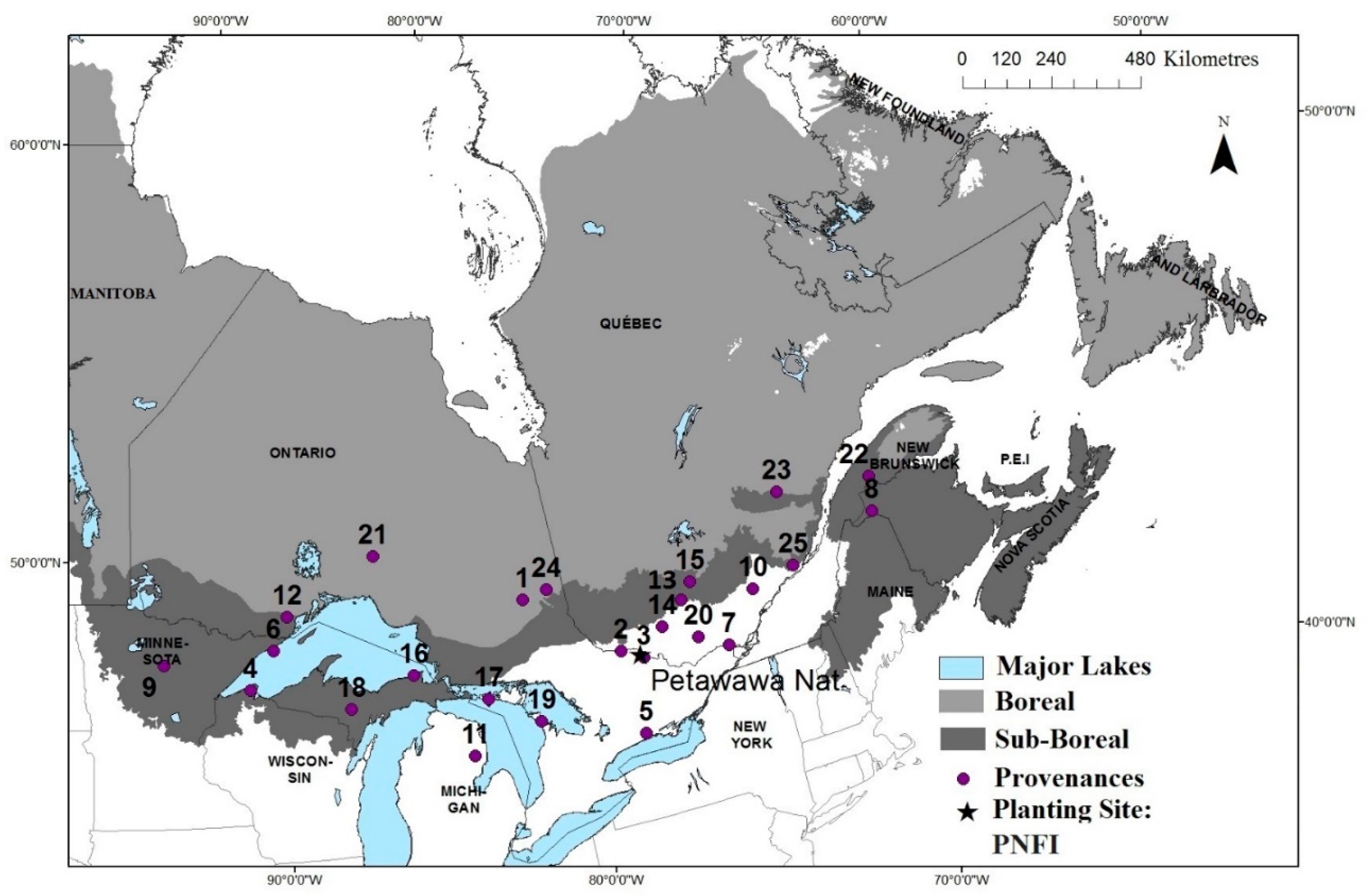
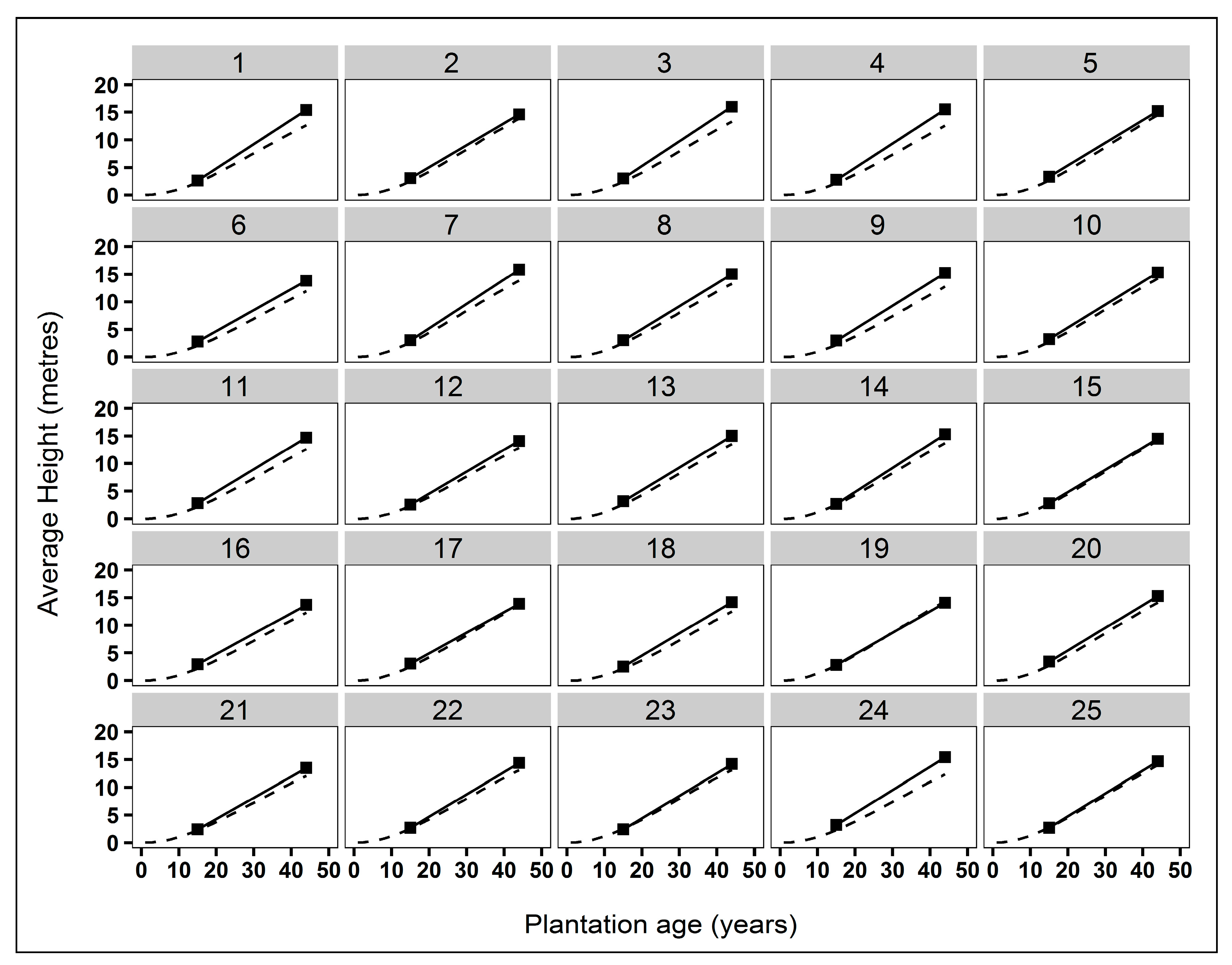
References
- Baraloto, C.; Alverga, P.; Baéz Quispe, S.; Barnes, G.; Bejar Chura, N.; Brasil da Silva, I.; Castro, W.; Da Souza, H.; De Souza Moll, I.; Del Alcazar Chilo, J.; et al. Trade-offs among forest value components in community forests of southwestern Amazonia. Ecol. Soc. 2014, 19. [Google Scholar] [CrossRef]
- D’Amours, S.; Ouhimmou, M.; Audy, J.-F.; Feng, Y. Forest Value Chain Optimization and Sustainability; CRC Press: Boca Raton, FL, USA, 2016. [Google Scholar]
- Canadian Forest Service. Canada Forest Facts 2016; Natural Resources Canada, Canadian Forest Service: Ottawa, ON, Canada, 2016.
- Zobel, B.; Talbert, J. Applied Forest Tree Improvement; John Wiley & Sons: New York, NY, USA, 1984. [Google Scholar]
- Kitzmiller, J.H. Managing genetic diversity in a tree improvement program. For. Ecol. Manag. 1990, 35, 131–149. [Google Scholar] [CrossRef]
- White, T.L.; Adams, W.T.; Neale, D.B. Forest Genetics; CABI Publishing: Cambridge, MA, USA, 2007. [Google Scholar]
- Weiskittel, A.R.; Hann, D.W.; Kershaw Jr, J.A.; Vanclay, J.K. Forest Growth and Yield Modeling, 2nd ed.; John Wiley & Sons: Chicester, UK, 2011. [Google Scholar]
- Jansson, G.; Hansen, J.K.; Haapanen, M.; Kvaalen, H.; Steffenrem, A. The genetic and economic gains from forest tree breeding programmes in Scandinavia and Finland. Scand. J. For. Res. 2017, 32, 273–286. [Google Scholar] [CrossRef]
- Lochhead, K.; Ghafghazi, S.; LeMay, V.; Bull, G.Q. Examining the vulnerability of localized reforestation strategies to climate change at a macroscale. J. Environ. Manag. 2019, 252, 109625. [Google Scholar] [CrossRef] [PubMed]
- Petrinovic, J.F.; Gélinas, N.; Beaulieu, J. Benefits of using genetically improved white spruce in Quebec: The forest landowner’s viewpoint. For. Chron. 2009, 85, 571–582. [Google Scholar] [CrossRef]
- Porth, I.; Bull, G.; Ahmed, S.; El-Kassaby, Y.A.; Boyland, M. Forest genomics research and development in Canada: Priorities for developing an economic framework. For. Chron. 2015, 91, 60–70. [Google Scholar] [CrossRef]
- Burton, P.J.; Messier, C.; Smith, D.W.; Adamowicz, W.L. Towards Sustainable Management of the Boreal Forest; NRC Research Press: Ottawa, ON, Canada, 2003. [Google Scholar]
- 8 Facts about Canada’s Boreal Forest. Available online: https://www.nrcan.gc.ca/our-natural-resources/forests-forestry/sustainable-forest-management/boreal-forest/8-facts-about-canadas-boreal-forest/17394 (accessed on 11 April 2020).
- Warf, B. (Ed.) Encyclopedia of Geography; Sage Publications: Thousand Oaks, CA, USA, 2010; ISBN 978-1-4129-5697-0. [Google Scholar]
- Brandt, J.P. The extent of the North American boreal zone. Environ. Rev. 2009, 17, 101–161. [Google Scholar] [CrossRef]
- Fowler, D.P.; Morgenstern, E.K. Tree improvement research and development in Canada. For. Chron. 1990, 66, 97–102. [Google Scholar] [CrossRef]
- Simpson, D.; Tosh, K. The New Brunswick Tree Improvement Council is 20 years old. For. Chron. 1997, 73, 572–577. [Google Scholar] [CrossRef][Green Version]
- McInnis, B.; Tosh, K. Genetic gains from 20 years of cooperative tree improvement in New Brunswick. For. Chron. 2004, 80, 127–133. [Google Scholar] [CrossRef]
- Carson, S.D.; Garcia, O.; Hayes, J.D. Realized gain and prediction of yield with genetically improved Pinus radiata in New Zealand. For. Sci. 1999, 45, 186–200. [Google Scholar]
- Mátyás, C. Modeling climate change effects with provenance test data. Tree Physiol. 1994, 14, 797–804. [Google Scholar] [CrossRef] [PubMed]
- Rweyongeza, D.M.; Barnhardt, L.K.; Hansen, C. Patterns of Optimal Growth for White Spruce Provenances in Alberta; Alberta Sustainable Resource Development: Smoky Lake, AB, Canada, 2011. [Google Scholar]
- Woods, J.H.; Kolotelo, D.; Yanchuk, A.D. Early selection of coastal Douglas-fir in a farm-field test environment. Silvae Genet. 1995, 44, 178–185. [Google Scholar]
- Xie, C.Y.; Yanchuk, A.D. Breeding values of parental trees, genetic worth of seed orchard seedlots, and yields of improved stocks in British Columbia. West. J. Appl. For. 2003, 18, 88–100. [Google Scholar] [CrossRef]
- Nance, W.L.; Wells, O.O. Site index models for height growth of planted loblolly pine (Pinus taeda L.) seed sources. In Proceedings of the 16th Southern Forest Tree Improvement Conference, Blacksburg, VA, USA, 27–28 May 1981; pp. 86–96. [Google Scholar]
- Jansson, G. Gains from selecting Pinus sylvestris in southern Sweden for volume per hectare. Scand. J. For. Res. 2007, 22, 185–192. [Google Scholar] [CrossRef]
- Magnussen, S.; Yanchuk, A.D. Time trends of predicted breeding values in selected crosses of coastal Douglas-fir in British Columbia: A methodological study. For. Sci. 1994, 40, 663–685. [Google Scholar]
- Newton, P.F. Systematic review of yield responses of four North American conifers to forest tree improvement practices. For. Ecol. Manag. 2003, 172, 29–51. [Google Scholar] [CrossRef]
- Beaulieu, J. Breeding Program and Strategy for White Spruce in Quebec; Canadian Forest Service: Ottawa, ON, Canada, 1996; Volume 117E, ISBN 978-0-662-24422-6.
- DerSimonian, R.; Laird, N. Meta-analysis in clinical trials. Control. Clin. Trials 1986, 7, 177–188. [Google Scholar] [CrossRef]
- Green, E.J.; Strawderman, W.E. A James-Stein type estimator for combining unbiased and possibly biased estimators. J. Am. Stat. Assoc. 1991, 86, 1001–1006. [Google Scholar] [CrossRef]
- Borenstein, M.; Hedges, L.V.; Higgins, J.P.; Rothstein, H.R. Introduction to Meta-Analysis; John Wiley & Sons: Chichester, UK, 2011. [Google Scholar]
- Gilliams, S.; Van Orshoven, J.; Muys, B.; Kros, H.; Heil, G.W.; Van Deursen, W. AFFOREST sDSS: A metamodel based spatial decision support system for afforestation of agricultural land. New For. 2005, 30, 33–53. [Google Scholar] [CrossRef]
- Raghunathan, T.E.; Diehr, P.K.; Cheadle, A.D. Combining aggregate and individual level data to estimate an individual level correlation coefficient. J. Educ. Behav. Stat. 2003, 28, 1–19. [Google Scholar] [CrossRef]
- Rehfeldt, G.E.; Tchebakova, N.M.; Barnhardt, L.K. Efficacy of climate transfer functions: Introduction of Eurasian populations of Larix into Alberta. Can. J. For. Res. 1999, 29, 1660–1668. [Google Scholar] [CrossRef]
- McLane, S.C.; LeMay, V.M.; Aitken, S.N. Modeling lodgepole pine radial growth relative to climate and genetics using universal growth-trend response functions. Ecol. Appl. 2011, 21, 776–788. [Google Scholar] [CrossRef] [PubMed]
- Leites, L.P.; Robinson, A.P.; Rehfeldt, G.E.; Marshall, J.D.; Crookston, N.L. Height-growth response to climatic changes differs among populations of Douglas-fir: A novel analysis of historic data. Ecol. Appl. 2012, 22, 154–165. [Google Scholar] [CrossRef] [PubMed]
- Oboite, F.O.; Comeau, P.G. Competition and climate influence growth of black spruce in western boreal forests. For. Ecol. Manag. 2019, 443, 84–94. [Google Scholar] [CrossRef]
- Burns, R.M. Silvics of North America: Conifers; US Department of Agriculture, Forest Service: Washington, DC, USA, 1990.
- Rajora, O.P.; Dancik, B.P. Population genetic variation, structure, and evolution in Engelmann spruce, white spruce, and their natural hybrid complex in Alberta. Can. J. Bot. 2000, 78, 768–780. [Google Scholar]
- Xie, C.Y.; Yanchuk, A.D. Genetic parameters of height and diameter of interior spruce in British Columbia. For. Genet. 2002, 9, 1–10. [Google Scholar]
- Varhola, A.; Coops, N.C.; Weiler, M.; Moore, R.D. Forest canopy effects on snow accumulation and ablation: An integrative review of empirical results. J. Hydrol. 2010, 392, 219–233. [Google Scholar] [CrossRef]
- Alberta Tree Improvement and Seed Centre. Genetic Test Analysis Report for Region E-White Spruce Tree Improvement-15 Year Results; Alberta Tree Improvement and Seed Centre: Edmonton, AB, Canada, 2011; p. 36. [Google Scholar]
- Morgenstern, K.; D’Eon, S.; Penner, M. White spruce growth to age 44 in a provenance test at the Petawawa Research Forest. For. Chron. 2006, 82, 572–578. [Google Scholar] [CrossRef]
- Hall, J.P. A Provenance Trial of White Spruce in Newfoundland: Twenty-Five Years from Seed; Newfoundland Forest Research Centre, Canadian Forestry Service: St. John’s, NL, Canada, 1986.
- Morgenstern, E.K.; Copis, P.L. Best White Spruce Provenances in Ontario; Canadian Forest Service Science: Ottawa, ON, Canada, 1999; Volume 16, ISBN 978-0-662-64009-7. [Google Scholar]
- Khalil, M.A.K. Twenty-Year Results of the Great Lakes—St. Lawrence Region White Spruce Provenance Test in Newfoundland; Information Report (St. John’s—Newfoundland and Labrador); Newfoundland Forest Research Centre: St. John’s, NL, Canada, 1979. [Google Scholar]
- Xie, C.-Y. Genotype by environment interaction and its implications for genetic improvement of interior spruce in British Columbia. Can. J. For. Res. 2003, 33, 1635–1643. [Google Scholar] [CrossRef]
- Burkhart, H.E.; Tomé, M. Modeling Forest Trees and Stands; Springer Science & Business Media: Berlin/Heidelberg, Germany, 2012. [Google Scholar]
- Pienaar, L.V.; Turnbull, K.J. The Chapman-Richards generalization of Von Bertalanffy’s growth model for basal area growth and yield in even-aged stands. For. Sci. 1973, 19, 2–22. [Google Scholar]
- Schumacher, F.X. A new growth curve and its application to timber yield studies. J. For. 1939, 37, 819–820. [Google Scholar]
- Korf, V. A mathematical definition of stand volume growth law. Lesn. Práce 1939, 18, 337–339. [Google Scholar]
- Lundqvist, B. On the height growth in cultivated stands of pine and spruce in Northern Sweden. Medd Fran Statens Skogforsk 1957, 47, 1–64. [Google Scholar]
- Zeide, B. Analysis of growth equations. For. Sci. 1993, 39, 594–616. [Google Scholar] [CrossRef]
- Akaike, H. Information theory and an extension of the maximum likelihood principle. In Proceedings of the International Symposium on Information Theory, Tsahkadsor, Armenia, 2–8 September 1971; Academiai Kiado: Budapest, Hungary, 1973; pp. 267–281. [Google Scholar]
- Von Bertalanffy, L. Quantitative laws in metabolism and growth. Q. Rev. Biol. 1957, 32, 217–231. [Google Scholar] [CrossRef]
- Pienaar, L.V.; Shiver, B.D. The effect of planting density on dominant height in unthinned slash pine plantations. For. Sci. 1984, 30, 1059–1066. [Google Scholar]
- Inions, G. Studies on the Growth and Yield of Plantation Eucalyptus globulus in South West Western Australia. Ph.D. Thesis, University of Western Australia, Crawley, Australia, 1992. [Google Scholar]
- Wong, J.; Baker, T.; Duncan, M.; McGuire, D.; Bulman, P. Forecasting Growth of Key Agroforestry Species in South-Eastern Australia: A Report for the RIRDC/LWRRDC/FWPRDC Joint Venture Agroforestry Program; RIRDC: Canberra, Australia, 2000; ISBN 978-0-642-58098-6. [Google Scholar]
- Wang, Y.; LeMay, V.M.; Baker, T.G. Modelling and prediction of dominant height and site index of Eucalyptus globulus plantations using a nonlinear mixed-effects model approach. Can. J. For. Res. 2007, 37, 1390–1403. [Google Scholar] [CrossRef]
- Clutter, J.L.; Fortson, J.C.; Pienaar, L.V.; Brister, G.H.; Bailey, R.L. Timber Management: A Quantitative Approach; John Wiley & Sons, Inc.: New York, NY, USA, 1983. [Google Scholar]
- Schabenberger, O.; Pierce, F.J. Contemporary Statistical Models for the Plant and Soil Sciences; CRC Press: Boca Raton, FL, USA, 2001. [Google Scholar]
- Littell, R.C.; Milliken, G.A.; Stroup, W.W.; Wolfinger, R.D.; Oliver, S. SAS for Mixed Models, 2nd ed.; SAS Publishing: Cary, NC, USA, 2006. [Google Scholar]
- Institute, S.A.S. Base SAS 9.4 Procedures Guide; SAS Institute: Cary, NC, USA, 2015. [Google Scholar]
- Efron, B.; Tibshirani, R. Improvements on cross-validation: The 632+ bootstrap method. J. Am. Stat. Assoc. 1997, 92, 548–560. [Google Scholar]
- McNelis, P.D. Neural Networks in Finance: Gaining Predictive Edge in the Market; Academic Press: New York, NY, USA, 2005. [Google Scholar]
- Prégent, G.; Picher, G.; Auger, I.; Québec (Province); Direction de la Recherche Forestière. Tarif de Cubage, Tables de Rendement et Modèles de Croissance Pour les Plantations D’épinette Blanche au Québec; Ministère des Ressources Naturelles et de la Faune, Direction de la Recherche Forestière: Québec, QC, Canada, 2010; ISBN 978-2-550-60588-1. [Google Scholar]
- R Core Team. R Foundation for Statistical Computing, 2016; R Core Team: Vienna, Austria, 2016. [Google Scholar]
- Huang, S.; Titus, S.J.; Wiens, D.P. Comparison of nonlinear height–diameter functions for major Alberta tree species. Can. J. For. Res. 1992, 22, 1297–1304. [Google Scholar] [CrossRef]
- Temesgen, H.; Hann, D.W.; Monleon, V.J. Regional height–diameter equations for major tree species of southwest Oregon. West. J. Appl. For. 2007, 22, 213–219. [Google Scholar] [CrossRef]
- Liu, Z.-G.; Li, F.-R. The generalized Chapman-Richards function and applications to tree and stand growth. J. For. Res. 2003, 14, 19–26. [Google Scholar] [CrossRef]
- Hanus, M.L.; Marshall, D.D.; Hann, D.W. Height-Diameter Equations for Six Species in the Coastal Regions of the Pacific Northwest; Oregon State University: Corvallis, OR, USA, 1999. [Google Scholar]
- Carter, K.K. Provenance tests as indicators of growth response to climate change in 10 north temperate tree species. Can. J. For. Res. 1996, 26, 1089–1095. [Google Scholar] [CrossRef]
- Andalo, C.; Beaulieu, J.; Bousquet, J. The impact of climate change on growth of local white spruce populations in Québec, Canada. For. Ecol. Manag. 2005, 205, 169–182. [Google Scholar] [CrossRef]
- Smith, D.M.; Larson, B.C.; Kelty, M.J.; Ashton, P.M.S. The Practice of Silviculture: Applied Forest Ecology; John Wiley and Sons, Inc.: New York, NY, USA, 1997. [Google Scholar]
- Bolghari, H.A.; Bertrand, V. Tables Préliminaires de Production des Principales Essences Résineuses Plantées dans la Partie Centrale du sud du Québec; Service de la Recherche (Terres et Forêts), Ministère de L’énergie et des Ressources: Québec, QC, Canada, 1984. [Google Scholar]
- Roussell, T.; Wang, E.; Erdle, T. STAMAN Stand Growth Model Version 3.05 User Manual 1993; VANGUARD FOREST MANAGEMENT SERVICES LTD: New Brunswick, Canada, 1993. [Google Scholar]
- Kimberley, M.O.; Moore, J.R.; Dungey, H.S. Quantification of realised genetic gain in radiata pine and its incorporation into growth and yield modelling systems. Can. J. For. Res. 2015, 45, 1676–1687. [Google Scholar] [CrossRef]

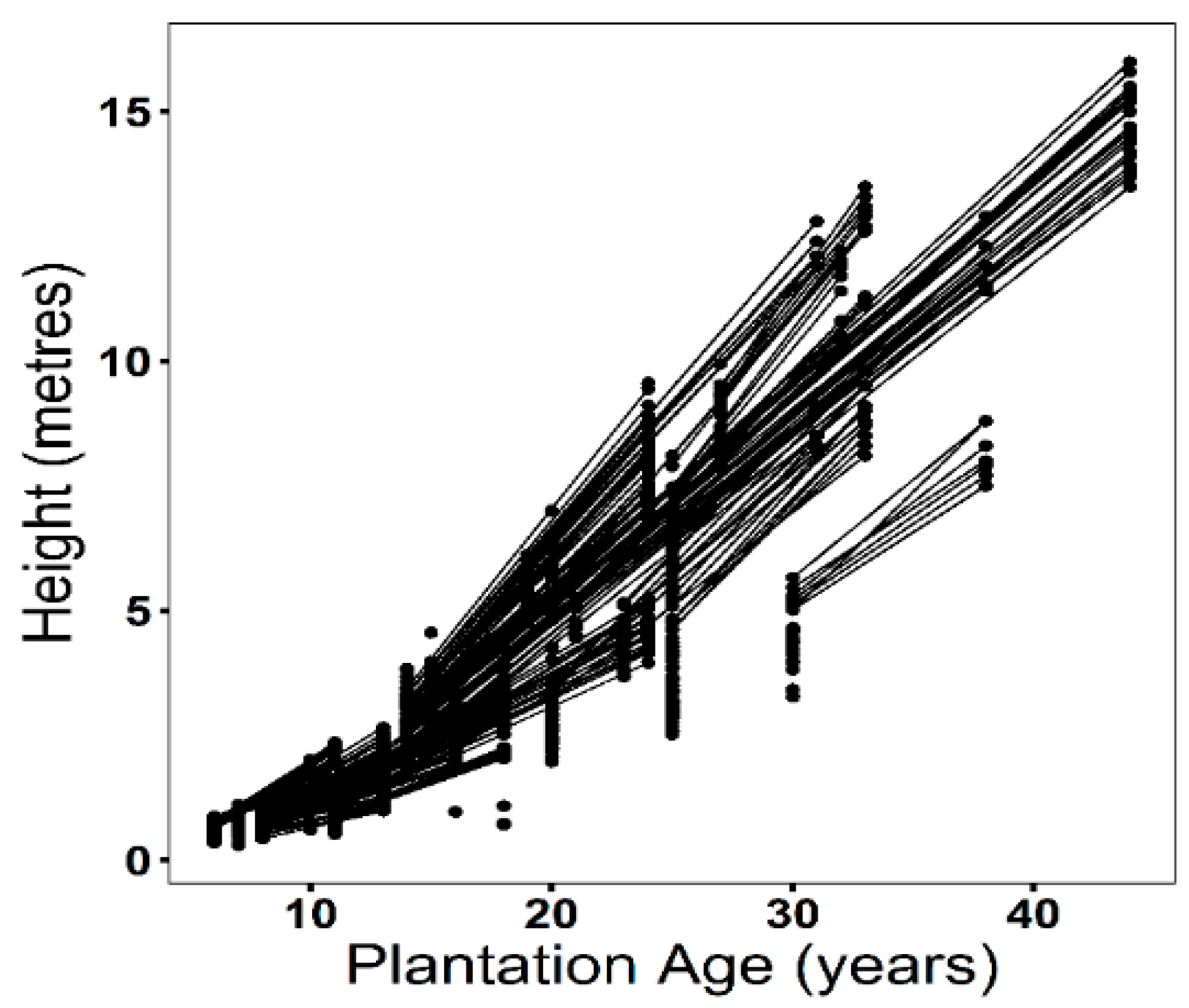
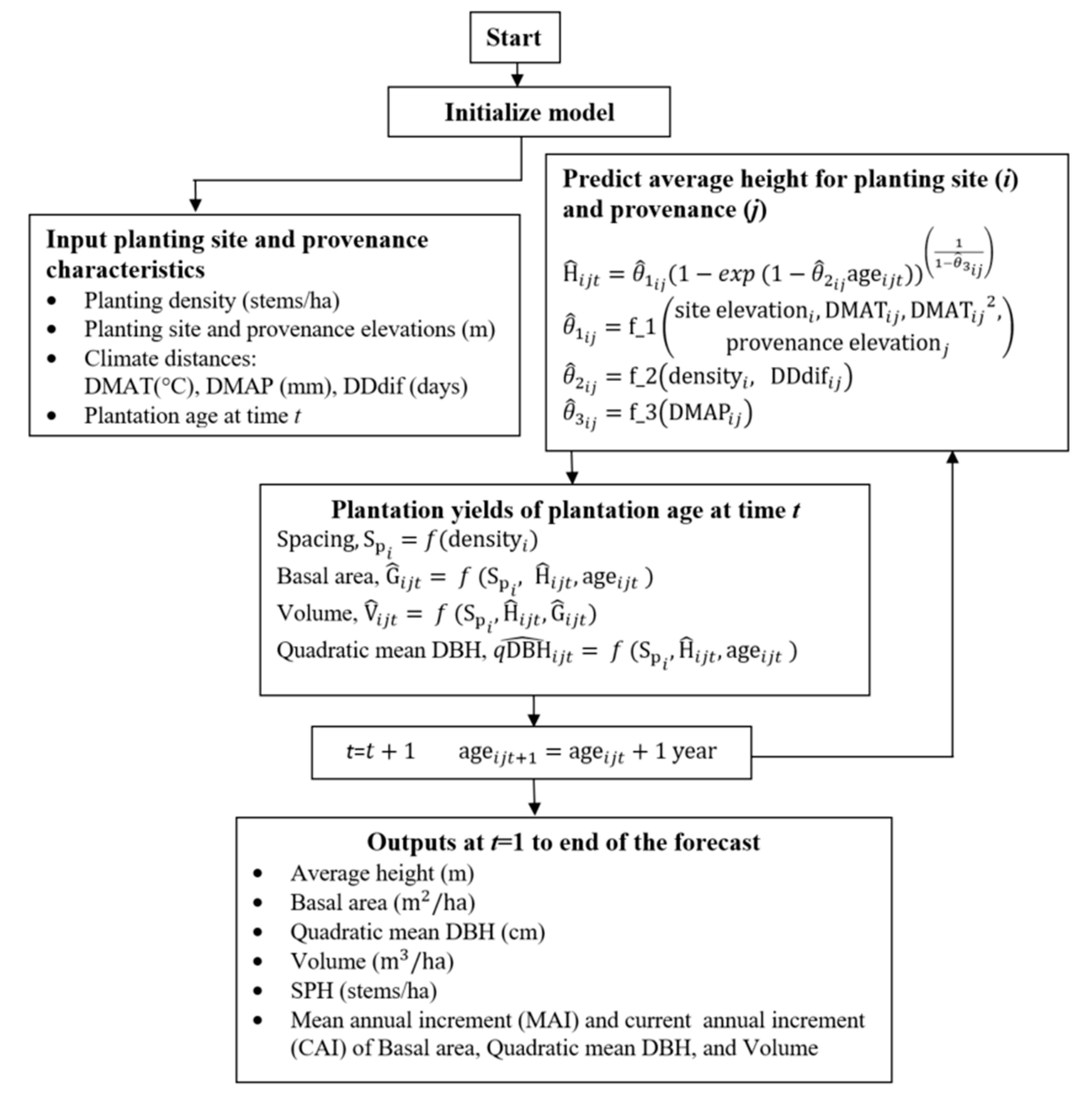
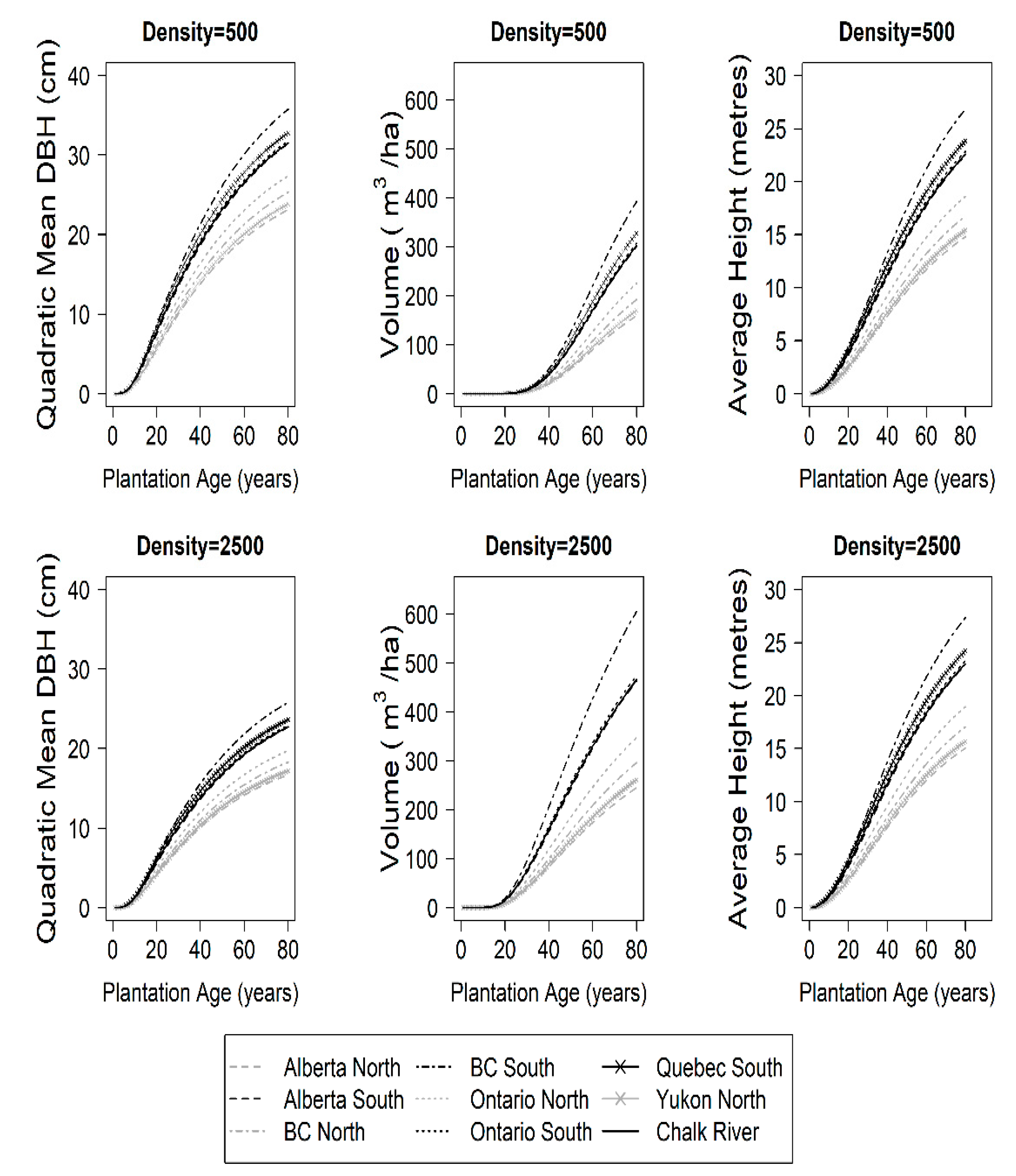
| Source | Province | Planting Site | Plantation Ages (years) | Number of Provenances Tested | Density (stems/ha) | Elevation (metres) |
|---|---|---|---|---|---|---|
| a [28] | Quebec | Drummondville | 20 | 11 | 6726 | 85 |
| ab [28] | Quebec | Casey | 14–24 | 28 | 3019 | 440 |
| ab [28] | Quebec | Grandes-piles | 14 | 20 | 3019 | 370 |
| a [28] | Quebec | Harrington | 14–20 | 41 | 6726 | 210 |
| ab [28] | Quebec | St-Jacques-des-Piles | 14–24 | 26 | 3019 | 393 |
| a [42] | Alberta | Calling Lake | 15 | 6 | 1600 | 625 |
| a [42] | Alberta | Kinosis Lake | 15 | 6 | 1600 | 495 |
| a [42] | Alberta | Wandering River | 15 | 6 | 1600 | 567 |
| a [43] | Ontario | Petawawa National Forestry Institute | 15–44 | 25 | 3086 | 170 |
| a [44] | Newfoundland | Gander | 25 | 32 | 3086 | 140 |
| a [45] | Ontario | Chalk River 1 | 6 | 73 | 666 | 170 |
| a [45] | Ontario | Chalk River 2 | 6–10 | 71 | 666 | 170 |
| a [45] | Ontario | Chalk River_194D1 | 27–33 | 25 | 15,625 | 170 |
| a [45] | Ontario | Chalk River_194M | 19–31 | 53 | 3086 | 170 |
| a [45] | Ontario | Chalk River_93C | 25–38 | 25 | 6726 | 170 |
| a [45] | Ontario | Dorset | 25–32 | 25 | 15,625 | 300 |
| a [45] | Ontario | Dryden | 11–16 | 77 | 3086 | 410 |
| a [45] | Ontario | Fort Frances | 11–18 | 66 | 157 | 340 |
| a [45] | Ontario | Hearst | 7–11 | 85 | 2500 | 320 |
| a [45] | Ontario | Kapuskasing | 20–33 | 25 | 3086 | 170 |
| a [45] | Ontario | Kenora | 11–18 | 49 | 157 | 410 |
| a [45] | Ontario | Lake Dore | 21–33 | 12 | 16,667 | 120 |
| a [45] | Ontario | Nipigon | 11–16 | 80 | 157 | 190 |
| a [45] | Ontario | Owen Sound | 6–12 | 64 | 2500 | 430 |
| a [45] | Ontario | Owen Sound_194E | 25–33 | 24 | 3086 | 430 |
| a [45] | Ontario | Owen Sound_93C | 30–38 | 25 | 6726 | 430 |
| a [45] | Ontario | Red Lake | 6–11 | 79 | 157 | 370 |
| a [45] | Ontario | Sudbury | 8–13 | 84 | 157 | 350 |
| a [45] | Ontario | Thunder Bay | 23–31 | 48 | 3086 | 300 |
| a [46] | Newfoundland | North Pond | 20 | 32 | 3086 | 71 |
| a [47] | British Columbia | Central Plateau | 10 | 6 | 2500 | 960 |
| a [47] | British Columbia | Fort Nelson | 10 | 6 | 2500 | 520 |
| a [47] | British Columbia | Hudson Hope | 10 | 6 | 2500 | 890 |
| a [47] | British Columbia | McGregor | 10 | 6 | 2500 | 670 |
| a [47] | British Columbia | Mount Robson | 10 | 6 | 2500 | 1000 |
| c Collected | British Columbia | Aleza Lake | 2–42 | 25 | 2500 | 700 |
| c Collected | British Columbia | Prince George Tree Improvement Station | 2–42 | 25 | 2500 | 610 |
| c Collected | British Columbia | Quesnel | 2–42 | 25 | 2500 | 915 |
| a Variable | Minimum | Mean | Maximum |
|---|---|---|---|
| Planting site latitude | 44.20 | 49.09 | 58.98 |
| Planting site longitude | −124.28 | −92.61 | −53.81 |
| Planting site elevation (metres) | 71.00 | 403.06 | 1000.00 |
| Provenance latitude | 43.70 | 49.48 | 62.03 |
| Provenance longitude | −139.00 | −94.14 | −55.85 |
| Provenance elevation (metres) | 20.00 | 450.62 | 1585.00 |
| Plantation age at last measurement (years) | 2.00 | 15.00 | 44.00 |
| Initial planting density (stems/ha) | 157.00 | 2455.00 | 16,667.00 |
| Site MAT (°C) | −0.50 | 3.99 | 6.85 |
| Site MAP (mm) | 423.40 | 811.12 | 1166.55 |
| Site DD (days) | 46.00 | 81.70 | 119.00 |
| Provenance MAT (°C) | −4.39 | 3.78 | 7.68 |
| Provenance MAP (mm) | 277.69 | 801.20 | 1590.78 |
| Provenance DD (days) | 28.00 | 74.00 | 203.00 |
| DMAT (°C) | −6.83 | 0.21 | 8.66 |
| DMAP (mm) | −731.05 | 9.92 | 861.90 |
| DDdif (days) | −132.00 | 2.47 | 85.00 |
| Model No. | Parameters | Fit Statistics | ||||
|---|---|---|---|---|---|---|
| RMSE | AIC | |||||
| 1 | + | 0.9224 | 0.9933 | 5922 | ||
| 2 | 0.9211 | 1.0017 | 5956 | |||
| 3 | 0.7873 | 1.6442 | 8032 | |||
| 4 | 0.6280 | 2.1744 | 9202 | |||
| 5 | 0.8972 | 1.1432 | 6488 | |||
| 6 | 0.9234 | 0.9866 | 5894 | |||
| Parameters | a Variable | Parameter Estimate (Standard Error) | 95% Confidence Intervals | ||
|---|---|---|---|---|---|
| Asymptote () | Intercept | 30 (2.6612) | 24.7841 | 35.2160 | |
| Site elevation (m) | −0.00513 (0.000819) | −0.00674 | −0.00353 | ||
| (°C) | −0.8768 (0.1163) | −1.1048 | −0.6488 | ||
| (°C, squared) | −0.1230 (0.0297) | −0.1813 | −0.0647 | ||
| Provenance elevation (m) | 0.00796 (0.000908) | 0.00618 | 0.00974 | ||
| Shape 1 () | Intercept | 0.0260 (0.00268) | 0.0207 | 0.0312 | |
| Density (stems ha−1) | 3.601 × 10−7 (3.835 × 10−8) | 2.849 × 10−7 | 4.352 × 10−7 | ||
| DDdif (days) | 0.000020 (3.066 × 10−6) | 0.000014 | 0.000026 | ||
| Shape 2 () | Intercept | 0.5674 (0.0204) | 0.5274 | 0.6074 | |
| DMAP (mm) | 0.000039 (7.475 × 10−6) | 0.000025 | 0.000054 | ||
© 2020 by the authors. Licensee MDPI, Basel, Switzerland. This article is an open access article distributed under the terms and conditions of the Creative Commons Attribution (CC BY) license (http://creativecommons.org/licenses/by/4.0/).
Share and Cite
Ahmed, S.; LeMay, V.; Yanchuk, A.; Robinson, A.; Marshall, P.; Bull, G. Meta-Modelling to Quantify Yields of White Spruce and Hybrid Spruce Provenances in the Canadian Boreal Forest. Forests 2020, 11, 609. https://doi.org/10.3390/f11060609
Ahmed S, LeMay V, Yanchuk A, Robinson A, Marshall P, Bull G. Meta-Modelling to Quantify Yields of White Spruce and Hybrid Spruce Provenances in the Canadian Boreal Forest. Forests. 2020; 11(6):609. https://doi.org/10.3390/f11060609
Chicago/Turabian StyleAhmed, Suborna, Valerie LeMay, Alvin Yanchuk, Andrew Robinson, Peter Marshall, and Gary Bull. 2020. "Meta-Modelling to Quantify Yields of White Spruce and Hybrid Spruce Provenances in the Canadian Boreal Forest" Forests 11, no. 6: 609. https://doi.org/10.3390/f11060609
APA StyleAhmed, S., LeMay, V., Yanchuk, A., Robinson, A., Marshall, P., & Bull, G. (2020). Meta-Modelling to Quantify Yields of White Spruce and Hybrid Spruce Provenances in the Canadian Boreal Forest. Forests, 11(6), 609. https://doi.org/10.3390/f11060609





